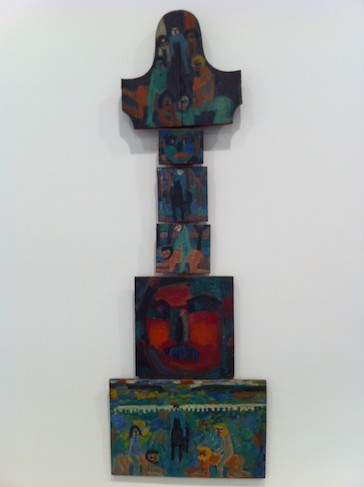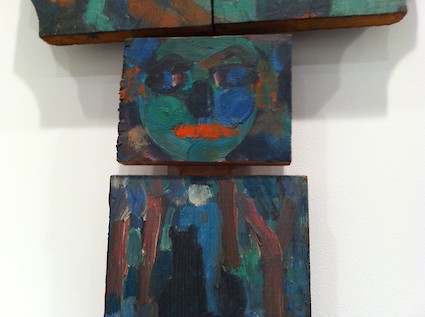Jan Muller's Church Hanging Piece

I wrote the essay below on Jan Muller's Church Hanging Piece to post on Kim Sloane's Blog, Thought – Form hight lighting the Show at Bookstein which ended June 23, 2012.
Hi Kim, Thanks for providing the forum and also for your thoughtful essay. I am familiar with Jan Muller’s small works; however, it is my first time to see these large-scale paintings. Many thanks to Lori Bookstein. Certainly, the large-scale Faustian paintings are quite powerful, however, I would like to direct yourattention to a smaller work. Please consider the multi-paneled “Church Hanging Piece (1957).”
It is comprised of six panels, stacked vertically, which are arranged to form another image: a silhouette of a winged angel on double pedestals. This oddly shaped piece is suggestive either of a simple totem or of monumental art, like an Egyptian goddess or a Madonna.
In this “Church Hanging Piece,” every panel contributes to the whole in narrating personal myth. It draws many elements from Muller’s other works: the rider on a black horse, mock horse-riders, Faustian witches and angels, St. Anthony's red-faced devil, squatting women, brunettes and blonds, a rape in the forest, night rituals, and the innocence of daylight.
 Aside from the narrative, this piece is a complex network of art and play, through various pictorial/painterly means: ideas about establishing a center, symmetry, geometric forms, scale shifts, repetition, patterns of shapes and colors, expected and unanticipated spatial moves, etc. The delivery is direct and simple.
Aside from the narrative, this piece is a complex network of art and play, through various pictorial/painterly means: ideas about establishing a center, symmetry, geometric forms, scale shifts, repetition, patterns of shapes and colors, expected and unanticipated spatial moves, etc. The delivery is direct and simple.
Starting at the top:

1. Night Scene. This arch-shaped panel suggests the head of an angel with a pair of broken wings. We are introduced to the blue rider on his black horse. At the top, flanking the central figure are a pair of angels, one red and one white. Below are four women posed as mock riders. On the right, one woman is squatting on top of another who is acting as a horse, an iconography known as the Aristotelian Perversion. This group is presented parallel to the picture plane. On the left, the woman who is playing the horse is in diagonal, while her rider is full length. The two groups of woman-riders and pony-girls are in inverted color schemes, switching between red and green. It’s also a quilt of inventive shapes of alternating dark umber and other colors. The composition, a central figure closely surrounded by adoring females (whose hair-dos double as halos), is reminiscent of Cimabue’s Maesta. But this version is an eerie parody suggesting rather a witches’ gathering.
2. Green Head. This face is so rough hewn that you cannot call it a portrait. Yet, this woman, with exaggerated red lips, refers to one of the pony-girls or mock riders from the Night Scene above.
3. Forest Scene. Again, the blue rider is presented almost frontally in a forest withtree trunks formed by vertical strokes, two on the left, and one on the right, and another in a Y-shape. We have seen the horse rider in this forest before, in Mueller’s other work, “Rape of Europa,” and “Search for the Unicorn.”
4. Mock Rider. This group is from the Night Scene. Perhaps the pony-girl of the right is now riding the pony-girl on the left. In contrast to the orientation of their bodies, both heads insist on frontal presentation. The white head of the mock rider is the apex of a triangular composition. The tree trunks suggest the same setting as the Forest Scene, but with more daylight.
5. The Devil. This is a much larger panel, forming the upper pedestal. As in the Green Head panel, this red face is the sole subject, mainly painted with a few patches of reds divided by darkblues. It suggests evil, temptation, and danger.
6. Open Field with Distant Aqueduct in Daylight. This is the largest panel and forms the bottom pedestal. We have been introduced to a number of characters, and they now reappear to create an epilogue or theatrical chorus. The blue rider and his black horse, the mock riders and their pony-girls, all gather in an open field ofblue and green patches, sprinkled with muted reds and yellows. It is now daylight, suggested by the red reflections of the sun at the top margin of the panel. Perhaps it is dawn after a night of ritual and revelry.
As in the Night Scene, two sets of figures (a pair of mock riders and a pair of pony-girls) flank the blue rider on his dark horse, establishing symmetry. The brunettes are on the left while the blonds are on the right. Their heads insist on frontal presentation. This entire grouping is located slightly left of the middle within the panel.
Within this composition, we can trace a large inverted triangle. Locate the negative space between the hands of the pony-girls. From here, the diagonals ascend and fan out, passing the heads of each woman, and extending to both sides of the aqueduct. The white line of the aqueduct, with variegated arches, forms the base of the inverted triangle. It is the most prominent horizontal line, not only of this panel, but also of the entire piece. On the left, the aqueduct ends with a small green dab just before it touches the edge, thus connecting the upper background with the open field below.
There is a pattern of interrupted horizontal lines. First, the head of the blue rider interrupts this slightly askew horizontal aqueduct. This interruption is highlighted with a dash of red on his black hair. Second, two dark stripes forming a mountain range are interrupted by an open space, a mountain gap. This negative space is just above and near the protagonist’s head. Above, a unit of white-red-white dashes further accentuates this mountain opening. From this red glob to the smaller dab of red by the head of the protagonist, an orthogonal line informs us of the space yonder.
The dark stripes of the distant mountains gently narrow toward the blue rider. The verticals of his dark horse continue the weaving of this curvilinear move. The interrupted horizontals and mountain contours emphasize the blue rider as the focal point of the painting. He seems to cast his glance convincingly past the mock rider to the open field on the right. This tightly woven landscape with figures is filled with sensitive touches. It recalls Cezanne’s painting of Aix-en-Provence.
There is urgency to the narrative, yet any definite meaning or message remains personal and illusive. The images of humans mimicking animals point to a time of pre-Christian pagan rituals. Are these people, posing as animals, being subjected to humiliation, or are they willing participants? Perhaps it is a fetish of degradation, a vestige conveyed here from the legendary decadence of the bygone Weimar Republic. Is the “Church Hanging Piece” then to be an anti-church piece, not to be hung in a church, rather to hang the Church?
Although an enigma, it is easy to suppose that the narrative is affected by disillusionment and nihilism widespread after the two World Wars, especially among those artists and intellectuals of German heritage. Painters such as Beckmann had direct experience evading the persecution of the Nazi’s, and Mueller’s own family escaped from the horrors of a Nazi concentration camp.
Throughout history, there have been disasters, wars, and disaffection. In the lasting aftermath of the Hundred Years War, the Black Death (responsible for the loss of a third of Europe’s population), and other catastrophic events like vast fires, we find artists such as Hieronymus Bosch, who painted fantasies of degradation and Church corruption. In Bosch tradition, it is not surprising that Jan Mueller also painted “The Temptation of Saint Anthony,” a journey of spiritual struggle and agony.
But more than a rejection of the Church, or Western Civilization in general, or any other eschatological (end-of-the-world) concept that we take from this strange and powerful piece, there is an emphatic point to make: we must ponder and appreciate Jan Muller’s passion and full engagement in both the story-telling and the craft drawn from the history of Western Art and its tradition to create something particularly original.
Younghee Choi Martin
June 18, 2012